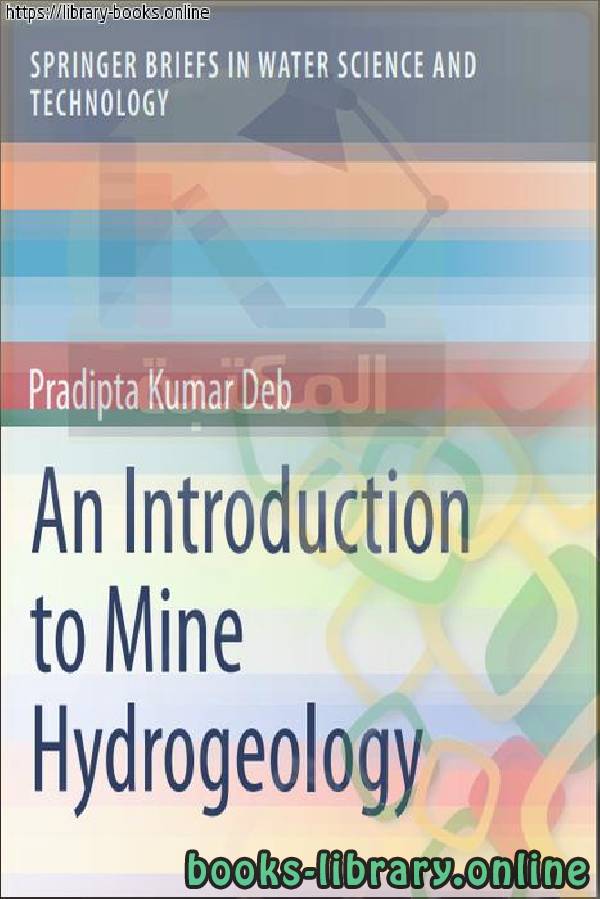📘 قراءة كتاب An Introduction to Mine Hydrogeology أونلاين


Biologically
Biology is a natural science that is concerned with the study of life, its various forms and its function, how these organisms interact with each other and with the surrounding environment. The word biology in Greek is made up of two words: bio (βίος) meaning life. And loggia (-λογία) means science or study. Biology: the similarity of vegetation and animal cover on the edges of the African and American states, and the existence of the same fossil.
Branches of biology
Biology is an ancient science thousands of years old and modern biology began in the nineteenth century. This science has multiple branches. Among them are:
Anatomy
Botany
Biochemia
Biogeography
Biofisia
Cytology or cell science
Ecology or environmental science
نبذه عن الكتاب:
Very often, in India, a mine planner or a mining engineer faces groundwater
seepage problems, in either in a running mine or in an open mine (whether open pit
or underground). This calls for a thorough in-depth hydrogeological analysis of the
mining area. In doing so, a professional mine hydrogeologist has threefold
responsibilities: (a) to ensure water supply to the mine or colonies or process
plants, (b) to assess the groundwater seepage potential into the mines, and (c) to
assess environmental impact on the surrounding hydrogeological regime.
In this book, various case studies in relation to mine hydrogeological studies
have been discussed. This study is unique because it emphasizes on the physical
impact of mining on the hydrogeological environs, which has been dealt with a
number of Indian case studies. This type of study has not been carried out earlier.
Mine hydrogeology deals with the hydrogeological study of a mine, opencast or
underground, in order to fulfil various requirements of the mine. In doing so, water
well inventory in the area should be conducted and a water table map or an
isopiestic map of the area should be prepared. Hydrogeological investigation needs
to be carried out along with groundwater exploration through well drilling.
Pumping tests of the exploratory well/s need to be carried out in the form of Step
Drawdown Test (SDT) and Aquifer Performance Test (APT). These would help to
determine the discharge, drawdown, and aquifer parameters like T, S, and K.
Depending on the water demand of mines, colonies and process plants and based
on the pumping test data, planning for groundwater development for the area needs
to be proposed.
For assessing groundwater seepage in the mine, mine development planning has
to be understood first. The optimum pit depth and pit limit have to be worked out
or known from the mine planners and aquifer disposition in the mine area needs to
be depicted. Basic objective is to keep the water table below the working bench
level in case of opencast mine, so that mineral or coal can be excavated without
any seepage problem. Therefore, groundwater seepage computation has to be
associated with the mine development planning. An underground mining project is
initiated by driving an incline or adit or by lowering a shaft cutting through the
geological formations. This means puncturing of both unconfined and confined
aquifers which contributes toward groundwater seepage to the mine. Proper
hydrogeological studies are required in such cases.
Biology
Human biology
Who is the founder of biology?
The importance of biology
Areas of work in the field of biology
Theories of biology
Research on biology for the first grade of secondary school
Human biology
سنة النشر : 2004م / 1425هـ .
حجم الكتاب عند التحميل : 1.160 .
نوع الكتاب : pdf.
عداد القراءة:
اذا اعجبك الكتاب فضلاً اضغط على أعجبني و يمكنك تحميله من هنا:

شكرًا لمساهمتكم
شكراً لمساهمتكم معنا في الإرتقاء بمستوى المكتبة ، يمكنكم االتبليغ عن اخطاء او سوء اختيار للكتب وتصنيفها ومحتواها ، أو كتاب يُمنع نشره ، او محمي بحقوق طبع ونشر ، فضلاً قم بالتبليغ عن الكتاب المُخالف:
 قبل تحميل الكتاب ..
قبل تحميل الكتاب ..
يجب ان يتوفر لديكم برنامج تشغيل وقراءة ملفات pdf
يمكن تحميلة من هنا 'http://get.adobe.com/reader/'


 منصّة المكتبة
منصّة المكتبة 